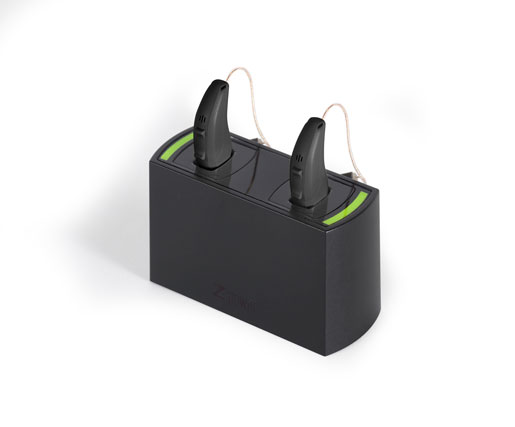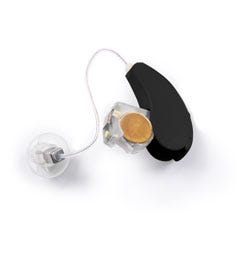Lose the Pile of Batteries! Hearing Aids Get New Rechargeable Option
ZPower has introduced a high-energy rechargeable battery that can be retrofitted for use with many major hearing aid brands, making it a convenient option for patients.
March 23, 2016

ZPower has introduced a high-energy rechargeable battery that can be retrofitted for use with many major hearing aid brands, making it a convenient option for patients.
Marie Thibault
Hearing aids retrofitted with ZPower batteries and customized battery doors can be recharged without requiring users to open the battery doors or remove the battery from the device.
Many hearing aid users rely upon disposable batteries to maintain their hearing and power their devices. It’s a surprising fact in a world where consumers have become accustomed to charging their phones or laptops.
ZPower, based in Camarillo, CA, is trying to change this. It has introduced its rechargeable battery technology to the hearing aid market, giving patients the opportunity to charge their hearing aids at night instead of changing out disposable batteries every few days.
While rechargeable batteries, mainly using nickel-metal hydride, do exist for the hearing aid market, Ross Dueber, PhD, ZPower’s president and CEO, said adoption has been limited because rechargeable batteries often have lower energy than a disposable and sometimes don’t last all day.
“A hearing aid battery is fairly highly demanding because of the fact that you’re wearing it for so long all the time and it’s always operating, as opposed to your laptop, where it spends a lot of time just in idle or even your cell phone, it just sits there. A hearing aid is always active,” Dueber said.
ZPower batteries use silver zinc technology, which isn’t entirely new but hasn’t been widely adopted for consumer electronics because of factors like cost and the price volatility of precious metal. The small size of hearing aid batteries offsets these concerns, allowing for the use of silver zinc technology. “It has more energy per volume, more energy per weight than a typical lithium ion battery has today that we use in our laptops, our cell phones, and our mobile devices,” said Dueber.
Get inspired to innovate during Massachusetts Medtech Week—register for BIOMEDevice Boston 2016, April 13-14. |
Patients may go through as many as 100 disposable batteries per hearing aid each year, depending on the hearing aid model and how often the device is used, Dueber said. In addition, newer models allow users to stream music and phone calls to their hearing aids, adding to the energy demand of the device. ZPower batteries can last 16-20 hours a day even with streaming use, he explained, and users can simply recharge the battery at night. Users can have the ZPower replaced, but that shouldn’t be necessary for at least a year, Dueber said.
To make recharging the batteries more seamless, ZPower has designed customized battery doors for various hearing aid models in order to enable recharging without necessitating removal of the batteries from the device. Patients who want a rechargeable option can have their hearing aid’s battery door switched out at the dispenser’s office.
Michael Andreozzi, BS, BC-HIS, sees this ease-of-use as a winning factor, from the perspective of both the patient and hearing professional. He should know. As the CEO of Beltone New England and Beltone Carolina-Virginia and as a hearing aid user himself, he pointed out that with ZPower rechargeable batteries, he doesn’t have to change batteries nor open battery doors. Instead, he and the patients who choose ZPower can just take off their hearing aids and drop them in the charger. A light changes color to let the user know the charging capability is engaged, he said.
|
ZPower's battery uses silver zinc technology. |
So far, Dueber said, ZPower has customized offerings for approximately 50% of the major hearing aid manufacturers and is targeting modern devices that enable Bluetooth streaming of music and phone calls since these models require frequent disposable battery changes. In addition to trade secrets, the company has over 100 patents worldwide on its battery technology, software algorithms, and the customized rechargeable battery door.
Dueber explained that ZPower strives to keep the cost neutral for patients when compared to disposable batteries, though individuals may end up saving money depending on how the hearing care provider prices the rechargeable option.
“The value in it is not so much in how much you were paying for a year’s supply worth of batteries or three or four years as much as it is simply the convenience of you not having to run to the store or order on the Internet and keep batteries all around your environment . . .” Dueber said.
ZPower’s limited launch has resulted in more than 100 offices selling the batteries and almost 3000 patients wearing the product. Dueber said the plan is to expand across the United States and into overseas markets in the near term.
Andreozzi said that when ZPower approached his Beltone dispenser almost a year ago about piloting the technology, he had just learned from a focus group study that a rechargeable hearing aid was repeatedly one of the top features patients wanted in a hearing aid. So, when he heard about ZPower’s ability to retrofit rechargeable battery doors on hearing aids, “I thought it was genius . . . frankly, I couldn’t believe nobody else thought of it, including myself.”
From a pilot test with over 100 patients that was received positively, Andreozzi said over 1600 of the dispensers’ patients use it now. He noted that as a patient, he is a heavy streamer but still gets a full day of battery life. What’s more, he’s seen the hearing aid return rate for ZPower battery-powered devices reduced by three or four percentage points from the average 12% seen in the industry.
ZPower’s technology is getting noticed beyond the industry. The company was recently named an Edison Award Finalist (winners will be announced in late April) and was also a CES 2016 Innovation Awards Honoree.
Dueber sees a number of additional opportunities for ZPower’s small, high-energy, rechargeable battery. “As we take a look at this whole hearables, wearables market that we hear about for on-body computing, the world’s going to need better, smaller batteries to enable that and we think we can be a significant contributor to enabling those new products to happen.”
Marie Thibault is the associate editor at MD+DI. Reach her at [email protected] and on Twitter @medtechmarie.
[Images courtesy of ZPOWER ]
About the Author(s)
You May Also Like



